Organizational Behavior: Flexible Hours and Gender Bias
VerifiedAdded on 2022/09/18
|5
|1345
|33
Report
AI Summary
This report delves into key aspects of organizational behavior, examining the impact of flexible work hours, stress, and gender bias within the workplace. Part A analyzes the implications of flexible business hours, evaluating their benefits and drawbacks for both employees and the organization, including the impact on work-life balance and employee productivity. Part B explores the negative roles of power and politics, particularly how gender bias affects women's experiences in the workplace, including hiring, leadership opportunities, and wage disparities. The report suggests strategies like diversity and inclusion initiatives and gender awareness training to mitigate bias and promote a more equitable and productive work environment. It also highlights the importance of a low-stress environment and employee well-being.
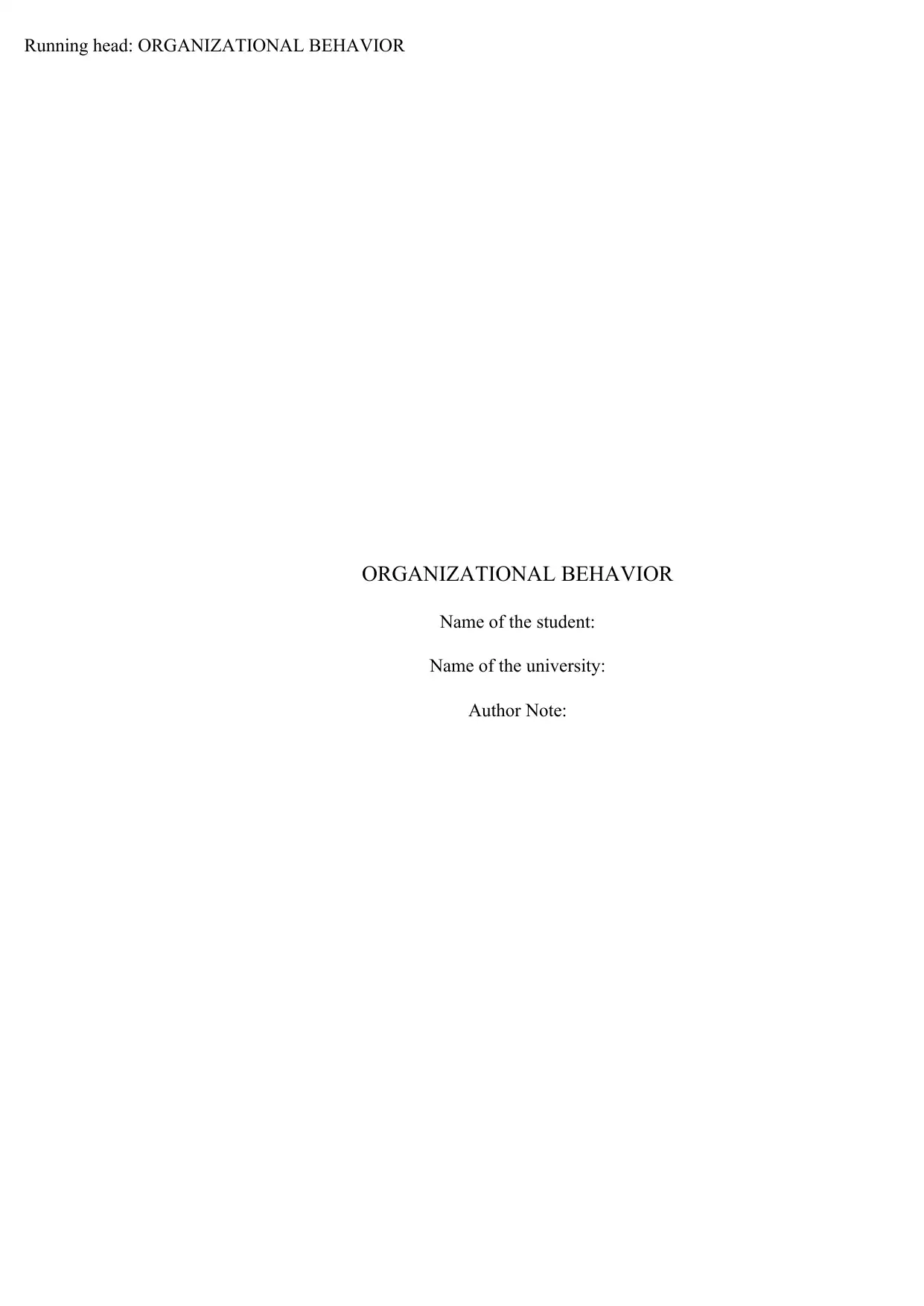
Running head: ORGANIZATIONAL BEHAVIOR
ORGANIZATIONAL BEHAVIOR
Name of the student:
Name of the university:
Author Note:
ORGANIZATIONAL BEHAVIOR
Name of the student:
Name of the university:
Author Note:
Paraphrase This Document
Need a fresh take? Get an instant paraphrase of this document with our AI Paraphraser
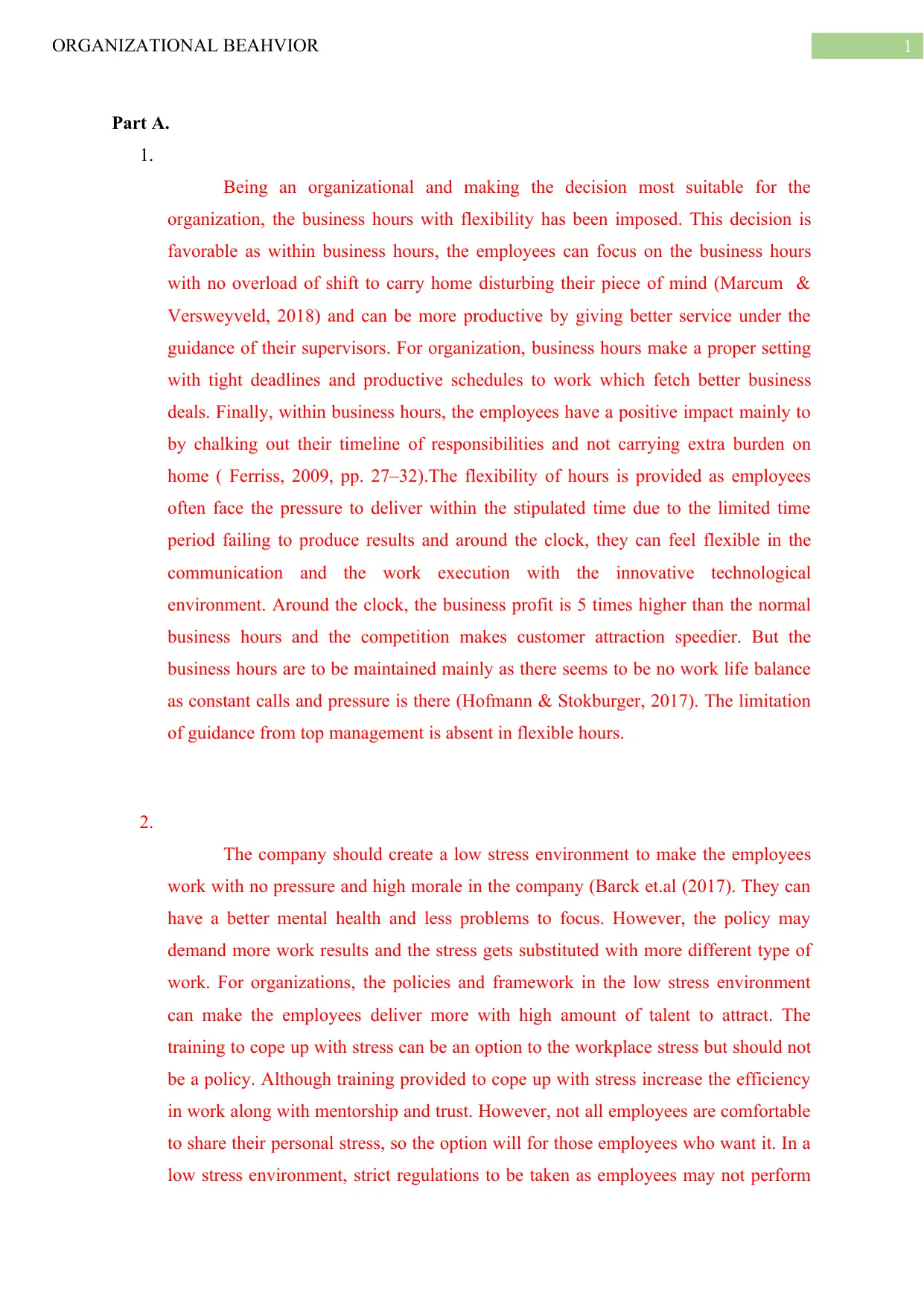
1ORGANIZATIONAL BEAHVIOR
Part A.
1.
Being an organizational and making the decision most suitable for the
organization, the business hours with flexibility has been imposed. This decision is
favorable as within business hours, the employees can focus on the business hours
with no overload of shift to carry home disturbing their piece of mind (Marcum &
Versweyveld, 2018) and can be more productive by giving better service under the
guidance of their supervisors. For organization, business hours make a proper setting
with tight deadlines and productive schedules to work which fetch better business
deals. Finally, within business hours, the employees have a positive impact mainly to
by chalking out their timeline of responsibilities and not carrying extra burden on
home ( Ferriss, 2009, pp. 27–32).The flexibility of hours is provided as employees
often face the pressure to deliver within the stipulated time due to the limited time
period failing to produce results and around the clock, they can feel flexible in the
communication and the work execution with the innovative technological
environment. Around the clock, the business profit is 5 times higher than the normal
business hours and the competition makes customer attraction speedier. But the
business hours are to be maintained mainly as there seems to be no work life balance
as constant calls and pressure is there (Hofmann & Stokburger, 2017). The limitation
of guidance from top management is absent in flexible hours.
2.
The company should create a low stress environment to make the employees
work with no pressure and high morale in the company (Barck et.al (2017). They can
have a better mental health and less problems to focus. However, the policy may
demand more work results and the stress gets substituted with more different type of
work. For organizations, the policies and framework in the low stress environment
can make the employees deliver more with high amount of talent to attract. The
training to cope up with stress can be an option to the workplace stress but should not
be a policy. Although training provided to cope up with stress increase the efficiency
in work along with mentorship and trust. However, not all employees are comfortable
to share their personal stress, so the option will for those employees who want it. In a
low stress environment, strict regulations to be taken as employees may not perform
Part A.
1.
Being an organizational and making the decision most suitable for the
organization, the business hours with flexibility has been imposed. This decision is
favorable as within business hours, the employees can focus on the business hours
with no overload of shift to carry home disturbing their piece of mind (Marcum &
Versweyveld, 2018) and can be more productive by giving better service under the
guidance of their supervisors. For organization, business hours make a proper setting
with tight deadlines and productive schedules to work which fetch better business
deals. Finally, within business hours, the employees have a positive impact mainly to
by chalking out their timeline of responsibilities and not carrying extra burden on
home ( Ferriss, 2009, pp. 27–32).The flexibility of hours is provided as employees
often face the pressure to deliver within the stipulated time due to the limited time
period failing to produce results and around the clock, they can feel flexible in the
communication and the work execution with the innovative technological
environment. Around the clock, the business profit is 5 times higher than the normal
business hours and the competition makes customer attraction speedier. But the
business hours are to be maintained mainly as there seems to be no work life balance
as constant calls and pressure is there (Hofmann & Stokburger, 2017). The limitation
of guidance from top management is absent in flexible hours.
2.
The company should create a low stress environment to make the employees
work with no pressure and high morale in the company (Barck et.al (2017). They can
have a better mental health and less problems to focus. However, the policy may
demand more work results and the stress gets substituted with more different type of
work. For organizations, the policies and framework in the low stress environment
can make the employees deliver more with high amount of talent to attract. The
training to cope up with stress can be an option to the workplace stress but should not
be a policy. Although training provided to cope up with stress increase the efficiency
in work along with mentorship and trust. However, not all employees are comfortable
to share their personal stress, so the option will for those employees who want it. In a
low stress environment, strict regulations to be taken as employees may not perform
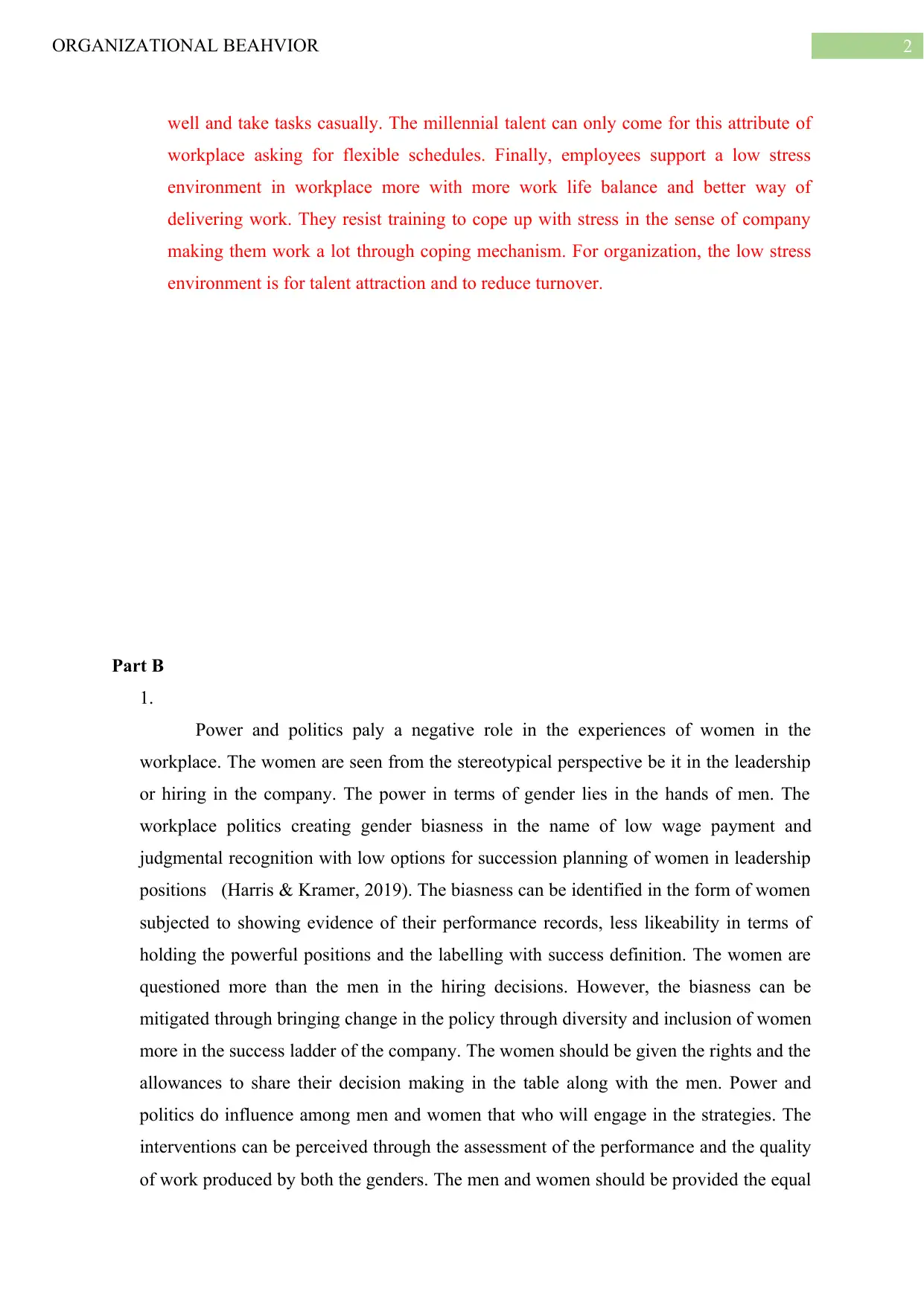
2ORGANIZATIONAL BEAHVIOR
well and take tasks casually. The millennial talent can only come for this attribute of
workplace asking for flexible schedules. Finally, employees support a low stress
environment in workplace more with more work life balance and better way of
delivering work. They resist training to cope up with stress in the sense of company
making them work a lot through coping mechanism. For organization, the low stress
environment is for talent attraction and to reduce turnover.
Part B
1.
Power and politics paly a negative role in the experiences of women in the
workplace. The women are seen from the stereotypical perspective be it in the leadership
or hiring in the company. The power in terms of gender lies in the hands of men. The
workplace politics creating gender biasness in the name of low wage payment and
judgmental recognition with low options for succession planning of women in leadership
positions (Harris & Kramer, 2019). The biasness can be identified in the form of women
subjected to showing evidence of their performance records, less likeability in terms of
holding the powerful positions and the labelling with success definition. The women are
questioned more than the men in the hiring decisions. However, the biasness can be
mitigated through bringing change in the policy through diversity and inclusion of women
more in the success ladder of the company. The women should be given the rights and the
allowances to share their decision making in the table along with the men. Power and
politics do influence among men and women that who will engage in the strategies. The
interventions can be perceived through the assessment of the performance and the quality
of work produced by both the genders. The men and women should be provided the equal
well and take tasks casually. The millennial talent can only come for this attribute of
workplace asking for flexible schedules. Finally, employees support a low stress
environment in workplace more with more work life balance and better way of
delivering work. They resist training to cope up with stress in the sense of company
making them work a lot through coping mechanism. For organization, the low stress
environment is for talent attraction and to reduce turnover.
Part B
1.
Power and politics paly a negative role in the experiences of women in the
workplace. The women are seen from the stereotypical perspective be it in the leadership
or hiring in the company. The power in terms of gender lies in the hands of men. The
workplace politics creating gender biasness in the name of low wage payment and
judgmental recognition with low options for succession planning of women in leadership
positions (Harris & Kramer, 2019). The biasness can be identified in the form of women
subjected to showing evidence of their performance records, less likeability in terms of
holding the powerful positions and the labelling with success definition. The women are
questioned more than the men in the hiring decisions. However, the biasness can be
mitigated through bringing change in the policy through diversity and inclusion of women
more in the success ladder of the company. The women should be given the rights and the
allowances to share their decision making in the table along with the men. Power and
politics do influence among men and women that who will engage in the strategies. The
interventions can be perceived through the assessment of the performance and the quality
of work produced by both the genders. The men and women should be provided the equal
⊘ This is a preview!⊘
Do you want full access?
Subscribe today to unlock all pages.

Trusted by 1+ million students worldwide
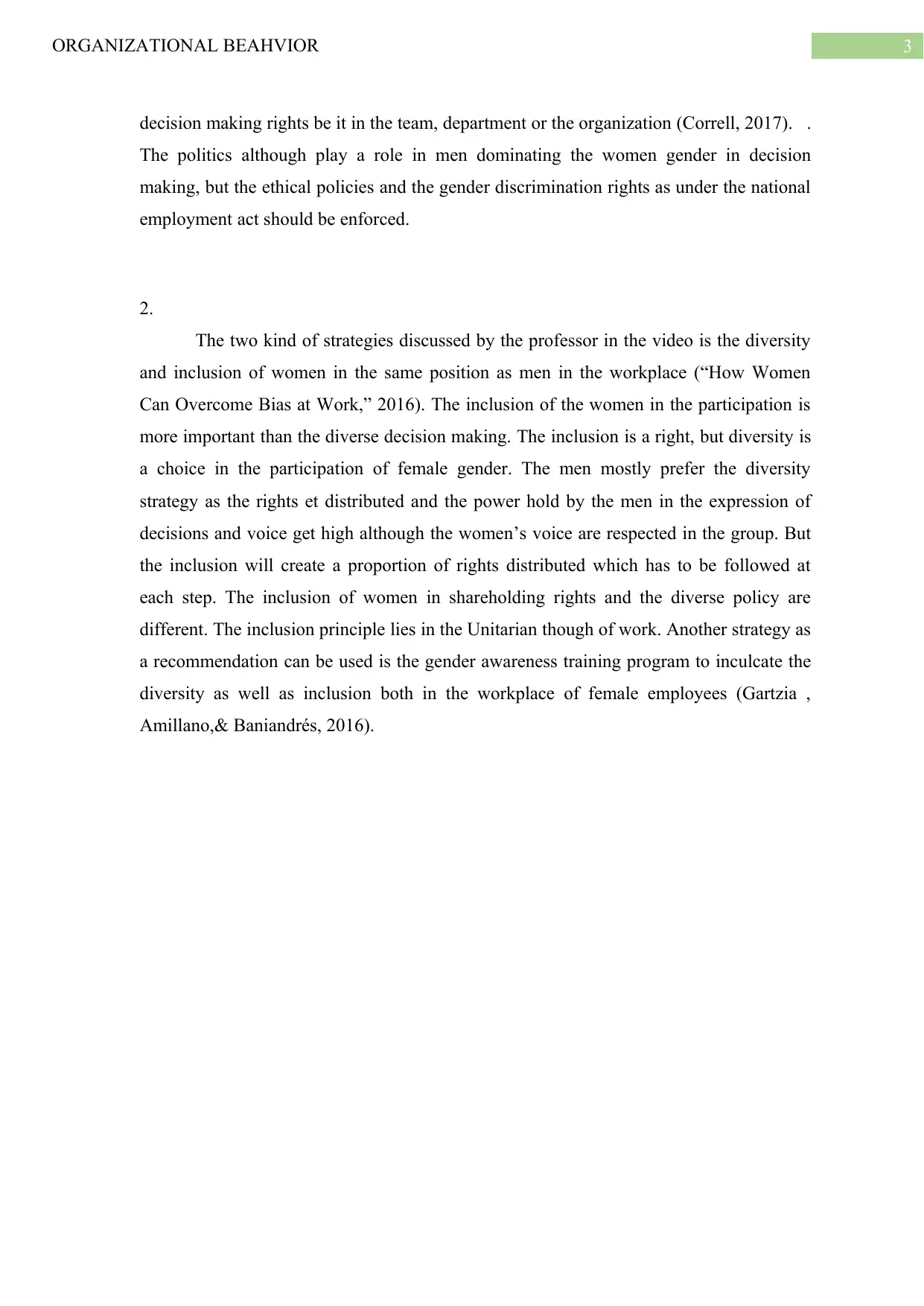
3ORGANIZATIONAL BEAHVIOR
decision making rights be it in the team, department or the organization (Correll, 2017). .
The politics although play a role in men dominating the women gender in decision
making, but the ethical policies and the gender discrimination rights as under the national
employment act should be enforced.
2.
The two kind of strategies discussed by the professor in the video is the diversity
and inclusion of women in the same position as men in the workplace (“How Women
Can Overcome Bias at Work,” 2016). The inclusion of the women in the participation is
more important than the diverse decision making. The inclusion is a right, but diversity is
a choice in the participation of female gender. The men mostly prefer the diversity
strategy as the rights et distributed and the power hold by the men in the expression of
decisions and voice get high although the women’s voice are respected in the group. But
the inclusion will create a proportion of rights distributed which has to be followed at
each step. The inclusion of women in shareholding rights and the diverse policy are
different. The inclusion principle lies in the Unitarian though of work. Another strategy as
a recommendation can be used is the gender awareness training program to inculcate the
diversity as well as inclusion both in the workplace of female employees (Gartzia ,
Amillano,& Baniandrés, 2016).
decision making rights be it in the team, department or the organization (Correll, 2017). .
The politics although play a role in men dominating the women gender in decision
making, but the ethical policies and the gender discrimination rights as under the national
employment act should be enforced.
2.
The two kind of strategies discussed by the professor in the video is the diversity
and inclusion of women in the same position as men in the workplace (“How Women
Can Overcome Bias at Work,” 2016). The inclusion of the women in the participation is
more important than the diverse decision making. The inclusion is a right, but diversity is
a choice in the participation of female gender. The men mostly prefer the diversity
strategy as the rights et distributed and the power hold by the men in the expression of
decisions and voice get high although the women’s voice are respected in the group. But
the inclusion will create a proportion of rights distributed which has to be followed at
each step. The inclusion of women in shareholding rights and the diverse policy are
different. The inclusion principle lies in the Unitarian though of work. Another strategy as
a recommendation can be used is the gender awareness training program to inculcate the
diversity as well as inclusion both in the workplace of female employees (Gartzia ,
Amillano,& Baniandrés, 2016).
Paraphrase This Document
Need a fresh take? Get an instant paraphrase of this document with our AI Paraphraser
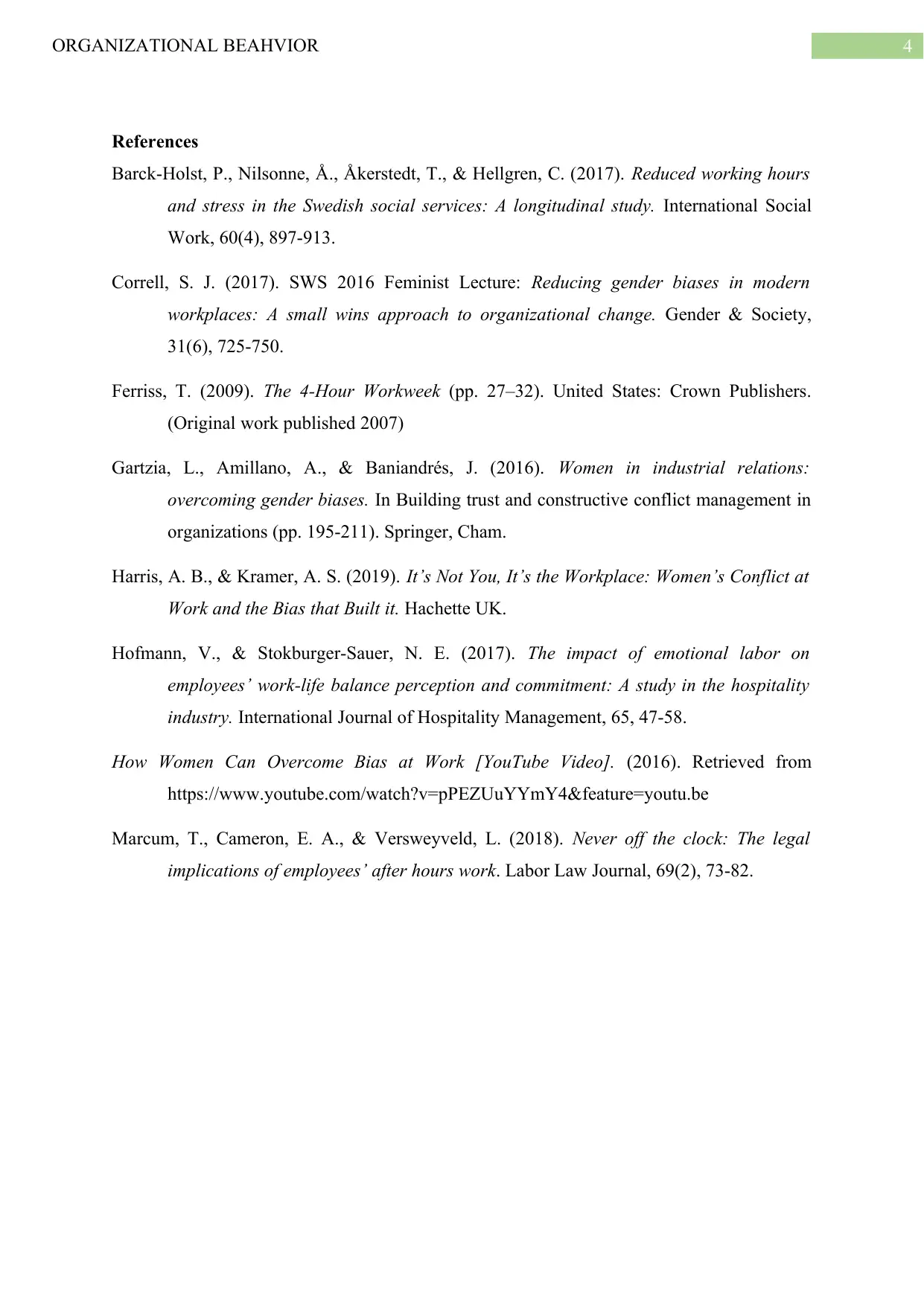
4ORGANIZATIONAL BEAHVIOR
References
Barck-Holst, P., Nilsonne, Å., Åkerstedt, T., & Hellgren, C. (2017). Reduced working hours
and stress in the Swedish social services: A longitudinal study. International Social
Work, 60(4), 897-913.
Correll, S. J. (2017). SWS 2016 Feminist Lecture: Reducing gender biases in modern
workplaces: A small wins approach to organizational change. Gender & Society,
31(6), 725-750.
Ferriss, T. (2009). The 4-Hour Workweek (pp. 27–32). United States: Crown Publishers.
(Original work published 2007)
Gartzia, L., Amillano, A., & Baniandrés, J. (2016). Women in industrial relations:
overcoming gender biases. In Building trust and constructive conflict management in
organizations (pp. 195-211). Springer, Cham.
Harris, A. B., & Kramer, A. S. (2019). It’s Not You, It’s the Workplace: Women’s Conflict at
Work and the Bias that Built it. Hachette UK.
Hofmann, V., & Stokburger-Sauer, N. E. (2017). The impact of emotional labor on
employees’ work-life balance perception and commitment: A study in the hospitality
industry. International Journal of Hospitality Management, 65, 47-58.
How Women Can Overcome Bias at Work [YouTube Video]. (2016). Retrieved from
https://www.youtube.com/watch?v=pPEZUuYYmY4&feature=youtu.be
Marcum, T., Cameron, E. A., & Versweyveld, L. (2018). Never off the clock: The legal
implications of employees’ after hours work. Labor Law Journal, 69(2), 73-82.
References
Barck-Holst, P., Nilsonne, Å., Åkerstedt, T., & Hellgren, C. (2017). Reduced working hours
and stress in the Swedish social services: A longitudinal study. International Social
Work, 60(4), 897-913.
Correll, S. J. (2017). SWS 2016 Feminist Lecture: Reducing gender biases in modern
workplaces: A small wins approach to organizational change. Gender & Society,
31(6), 725-750.
Ferriss, T. (2009). The 4-Hour Workweek (pp. 27–32). United States: Crown Publishers.
(Original work published 2007)
Gartzia, L., Amillano, A., & Baniandrés, J. (2016). Women in industrial relations:
overcoming gender biases. In Building trust and constructive conflict management in
organizations (pp. 195-211). Springer, Cham.
Harris, A. B., & Kramer, A. S. (2019). It’s Not You, It’s the Workplace: Women’s Conflict at
Work and the Bias that Built it. Hachette UK.
Hofmann, V., & Stokburger-Sauer, N. E. (2017). The impact of emotional labor on
employees’ work-life balance perception and commitment: A study in the hospitality
industry. International Journal of Hospitality Management, 65, 47-58.
How Women Can Overcome Bias at Work [YouTube Video]. (2016). Retrieved from
https://www.youtube.com/watch?v=pPEZUuYYmY4&feature=youtu.be
Marcum, T., Cameron, E. A., & Versweyveld, L. (2018). Never off the clock: The legal
implications of employees’ after hours work. Labor Law Journal, 69(2), 73-82.
1 out of 5
Related Documents
Your All-in-One AI-Powered Toolkit for Academic Success.
+13062052269
info@desklib.com
Available 24*7 on WhatsApp / Email
![[object Object]](/_next/static/media/star-bottom.7253800d.svg)
Unlock your academic potential
Copyright © 2020–2025 A2Z Services. All Rights Reserved. Developed and managed by ZUCOL.





